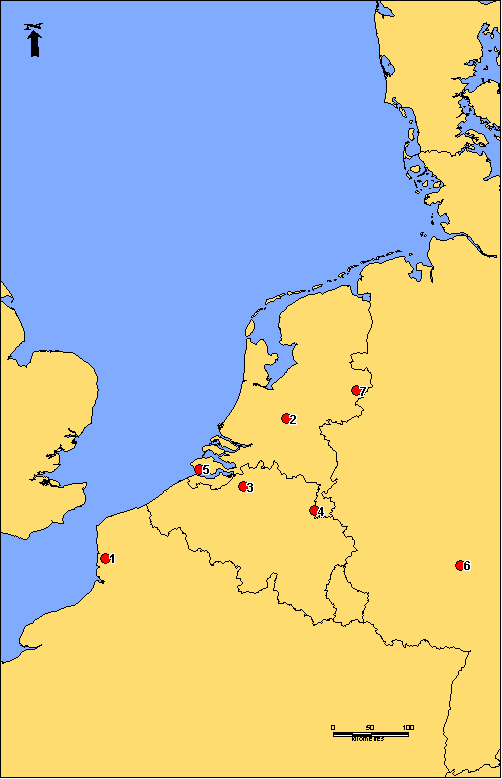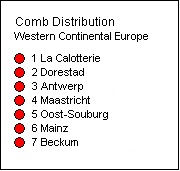

The situation in continental Europe to the west of the Baltic is a little unclear, principally because the acidic soils that characterise much of this region result in poor preservation of bone and antler (Callmer 1998, 470). Nonetheless, some broad patterns are discernible. Our understanding of the situation in early post-Roman north-western Europe is secure, as a profusion of cemeteries in the Rhineland and North Rhine-Westphalia allows us to date with some precision the date of appearance of the earliest comb forms included in the present classification. Alongside the simple, one-piece, single-sided comb (not considered in detail here), Type 1a is a common find in cremation and inhumation cemeteries here, and in surrounding regions (see Frank 1997, 70, no. 71; Quast 1993, 96-99, taf. 18; Saggau 1981, taf. 38; Schach-Dörges 1994; Schmidt 1999, 354; Zimmer-Linnfeld et al. 1960, taf. 23, 151, 153), as are Types 10 and 11 (Koch 1997, 192, no. 193; Zimmer-Linnfeld et al. 1960, taf. 21), appearing in late 4th- or 5th-century contexts (Bücker et al. 1997, 317, no. 342) and 12 (Schiek et al. 1992, taf. 79; Theune-Grosskopf 1997, 240, no. 253). Also found in early medieval inhumation cemeteries are hybrids of Types 1a and 2 (long combs with flat connecting plates of elongate triangular profile), as well as early examples of Type 2 itself (Schiek et al. 1992, taf. 61; Pescheck 1996, taf. 78, 97; Saggau 1981, taf. 54), and Type 3 (asymmetric form) (Pirling 1979, taf. 39, 101).
As we progress into the 6th and 7th centuries, there is a little less material to work with, but the corpus may still be characterised with some precision. A recent survey (Petitjean 1995) of Merovingian comb material from the Continent (considering collections from Normandy, Ile-de-France, Picardie, Champagne-Ardennes, Belgium, the Rhineland, Burgundy and Lorraine, and focusing particularly upon material from furnished inhumations) demonstrates the presence of Types 1a, 2a, 2b, 2c, 3, 10, 11, 12 and 14c between the 5th and 8th centuries, and readers with an interest in the French comb material in particular are referred to this magisterial work for an overview.
However, characterising the corpus of the late first millennium AD is much more problematic, as from the end of the 8th century, our knowledge of continental combs declines in line with the frequency of furnished burials. Thankfully, a recent survey of material from the Frisian and southern Baltic areas by Johan Callmer (1998, 474-5) has brought together published and unpublished material from a range of sites. Callmer has shown that double-sided forms (i.e. Types 11 and 12) were dominant across much of western and central Europe in the 7th century, and has also demonstrated that single-sided combs (principally of Types 2a and 2b) start to appear in high-status male graves around this date. Callmer's patterns are broadly supported by evidence from the wider literature surveyed as part of the present research (see, for instance, Petitijean 1995; Quast 1994). It must be said that combs from the 9th and 10th centuries are not well represented in the published literature, notwithstanding art historical treatments of the well-known Carolingian 'liturgical' combs (Type 14c here). Nonetheless, it has frequently been noted that objects of distinctive 'Scandinavian' form are rarely recovered in France, even in Normandy, where toponymic evidence appears to offer support for a narrative of Norse settlement (see Jaubert 2001; Roesdahl 2003). One might thus expect that combs could - like other forms of artefact - be broadly placed within a continental tradition (i.e. tending toward dominance by the pre-existing Types 2b, 3 and 12, rather than 5, 6, or 7). Of course, such assumptions must be tested, and we await further work in this area.
Northern France | The Netherlands and Belgium | 'Frisian combs'
There is still much work to be done on the combs of western continental Europe. Poor preservation and a lack of large, well-dated collections make it difficult to construct a chronology, particularly for the period between the 9th and 11th centuries. Recently excavated material from urban sites in France and the Netherlands thus has considerable significance and potential.
The comments facility has now been turned off.
title="Western continental Europe">© Internet Archaeology/Author(s)
University of York legal statements | Terms and Conditions
| File last updated: Tue Sep 20 2011